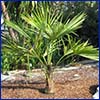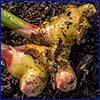The Neighborhood Gardener – February

Florida's Edible Native Plants
 Only a few of Florida's edible native plants are grown commercially. Many don't ship well and a couple are more of an acquired taste. Some gardeners, however, are passionate about native foodscapes. They say that having native plants on the menu makes them feel a connection to the land. Whether or not you decide to eat them, our native edibles are worth knowing. Consider this article a lesson in ethnobotany rather than a menu of native plants.
Only a few of Florida's edible native plants are grown commercially. Many don't ship well and a couple are more of an acquired taste. Some gardeners, however, are passionate about native foodscapes. They say that having native plants on the menu makes them feel a connection to the land. Whether or not you decide to eat them, our native edibles are worth knowing. Consider this article a lesson in ethnobotany rather than a menu of native plants.
Windmill Palm
 The windmill palm is a pint-sized palm that does well in tight spaces. It likes the shade and tolerates cold well, too. Windmill palms grow as far north as Canada and Scotland, but they're also an attractive choice for North and Central Florida gardens. If you're looking for a Florida-Friendly addition to an entry way or courtyard, windmill palm is just right. Read this newly expanded article on windmill palm.
The windmill palm is a pint-sized palm that does well in tight spaces. It likes the shade and tolerates cold well, too. Windmill palms grow as far north as Canada and Scotland, but they're also an attractive choice for North and Central Florida gardens. If you're looking for a Florida-Friendly addition to an entry way or courtyard, windmill palm is just right. Read this newly expanded article on windmill palm.
Walking Iris
 Neomarica species get their most common name, walking iris, from their propagation habit. New plantlets form at the tops of flower stalks. As they grow, the stalks bend to the ground and the plantlet takes root. Eventually, the new plant will repeat the same process. In this way many walking iris plants "walk" through the landscape. Walking iris is not native to Florida but it is considered a Florida-Friendly plant. It is commonly found in USDA Hardiness Zones 8B–11. Read more about this popular passalong plant.
Neomarica species get their most common name, walking iris, from their propagation habit. New plantlets form at the tops of flower stalks. As they grow, the stalks bend to the ground and the plantlet takes root. Eventually, the new plant will repeat the same process. In this way many walking iris plants "walk" through the landscape. Walking iris is not native to Florida but it is considered a Florida-Friendly plant. It is commonly found in USDA Hardiness Zones 8B–11. Read more about this popular passalong plant.
Wendy's Wanderings
 Have you noticed the increase of prices at the stores? It is not just at the grocery store either. Higher prices have found their way to the garden centers and it is eating into my plant budget. This makes me consider a few coping strategies to stretch a dollar in the garden and the landscape. Before you head out to the store to purchase items for your new project, really look at what you already have. Read on for more of Wendy's ways to save money in the garden.
Have you noticed the increase of prices at the stores? It is not just at the grocery store either. Higher prices have found their way to the garden centers and it is eating into my plant budget. This makes me consider a few coping strategies to stretch a dollar in the garden and the landscape. Before you head out to the store to purchase items for your new project, really look at what you already have. Read on for more of Wendy's ways to save money in the garden.
Plant of the Month: Edible Ginger
 The leafy, grassy foliage of edible ginger adds a tropical backdrop for more colorful plants, but is best known for its underground stems, or rhizomes. This is the part of the plant that produces the "ginger" spice we love. It grows well throughout the state, too, as long as the soil is amended with organic matter. And for gardeners with tree-covered landscapes, ginger is one of the few crops that loves some shade. Learn more about Zingiber officinale.
The leafy, grassy foliage of edible ginger adds a tropical backdrop for more colorful plants, but is best known for its underground stems, or rhizomes. This is the part of the plant that produces the "ginger" spice we love. It grows well throughout the state, too, as long as the soil is amended with organic matter. And for gardeners with tree-covered landscapes, ginger is one of the few crops that loves some shade. Learn more about Zingiber officinale.
February in Your Garden
 This is a good month for planting bulbs like crinum and agapanthus. Provide adequate water for establishment and protect them from cold with mulch. Prune roses this month to remove damaged canes and improve the overall form. After pruning, fertilize and apply a fresh layer of mulch. In South Florida, winter vegetable gardening is in full swing; this is the last month to plant cantaloupes, cucumbers, eggplant, lettuce, peppers, spinach, and tomatoes for a late spring harvest.
This is a good month for planting bulbs like crinum and agapanthus. Provide adequate water for establishment and protect them from cold with mulch. Prune roses this month to remove damaged canes and improve the overall form. After pruning, fertilize and apply a fresh layer of mulch. In South Florida, winter vegetable gardening is in full swing; this is the last month to plant cantaloupes, cucumbers, eggplant, lettuce, peppers, spinach, and tomatoes for a late spring harvest.
For more month-by-month gardening tips, check out the Florida Gardening Calendar. Three different editions of the calendar provide specific tips for each of Florida's gardening regions—North, Central, and South.
What's Going On?
If your Master Gardener Volunteer program or Extension office is having an event, be sure to share it with us.

